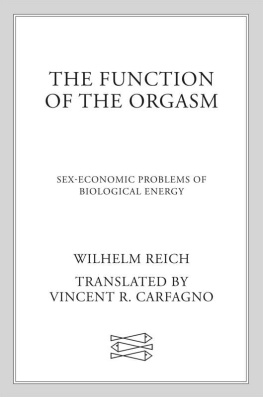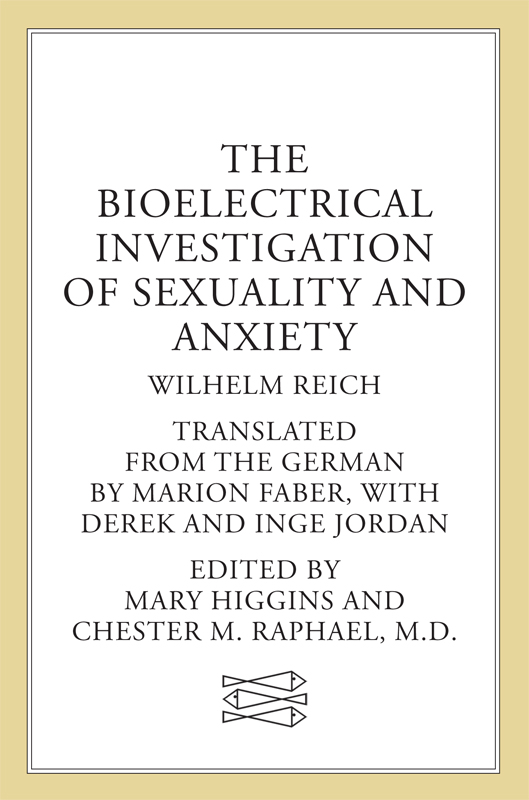
The author and publisher have provided this e-book to you for your personal use only. You may not make this e-book publicly available in any way. Copyright infringement is against the law. If you believe the copy of this e-book you are reading infringes on the authors copyright, please notify the publisher at: us.macmillanusa.com/piracy.
Contents
Love, work and knowledge are the wellsprings of our life. They should also govern it.
W ILHELM R EICH

Foreword
My experimental studies during the years 1934 to 1938 gradually and logically centered on a single basic problem: how deeply is the function of the orgasm rooted in biology?
This book is composed of three studies from that period. They follow one another in a logical sequence which reflects the various stages of progress made in the development of orgone biophysics, a process which began in 1934 when I achieved a breakthrough into the biological foundation of psychoneuroses. The present volume can with good reason be understood as a logical continuation of my Character Analysis. It is the character analysis of the areas of biological functioning, so to speak. The discovery of biological energy, the orgone, was made solely as a result of the consistent and logical nature of the sex-economic theory of the biopsychic apparatus. At certain places in these studies, which were completed before 1939i.e., before the discovery of the orgonethe reader will find statements and assumptions which were later fully confirmed by the previously unknown orgonotic pulsation function. The relevant places are marked by footnotes [1945].
The logic of the development of sex-economy into orgone biophysics is objective proof of its unbiased nature. If someone traversing unknown territory concludes from seemingly unimportant signs that a huge lake is nearby, and then, following these signs, actually comes to a great lake, that is proof enough that he has observed and interpreted the signs correctly.
Orgone biophysics is firmly based on the foundation of direct observation, experimental testing of these observations, logical development of experiments, and interpretations that keep pace with the work process. It fills many gaps in natural science; for the first time, objective natural processes are concretely linked with subjective emotional life.
W. R.
1945
The Orgasm as an Electrophysiological Discharge
Although in his compilation Die Lebensnerven (3rd ed., Springer, 1930) Mller makes general mention of the relationship between orgasm and the contraction of the smooth muscles, the physiology of orgastic excitation has remained unexplained. To my knowledge; there have been no experiments on animals or humans. Various disorders are described in the sexological literature, but they are not considered in the context of how they relate to unconscious psychic life, or to the physiology of the sexual function, or to the social conditions of peoples sex lives.
An orgasm is more complete and provides greater release the more the sexual excitation has been concentrated in the genitals and the more completely this excitation then ebbs away within the vegetative nervous system. The nature of this excitation is crucially important to the understanding of sexuality in general.
In the clinical treatment of neuroses and sexual disorders, orgasm is found to be a process of excitation which is characterized by the complete reduction of all psychic activity to vegetative tension and relaxation. We came to understand orgastic potency as the ability to allow, free of all inhibitions, a relaxation of the corresponding tension that has accumulated in the biophysical apparatus, and to experience it fully.
The following questions must be answered:
Is sexual tension nothing more than a mechanical phenomenon?
Is sexual stasis, then, an essentially mechanical process?
Is the relaxation that occurs with orgasm a mechanical relief, resulting from the emptying of engorged seminal vesicles or sperm ducts, as many opinions would have it, or does it involve merely a mechanical change in the surface tension of the sex organs?
These and similar questions demand an answer, for neuroses cannot be properly treated or prevented in the context of social sex-economy until these problems have been adequately settled. If the theory of sex-economy is correct in contending that orgastic potency is the key to understanding the economy and dynamics of emotional life in general and of psychic disorders in particular, then one must understand the orgasm problem in order to understand neuroses, and vice versa.
SOME PECULIAR FEATURES OF SEXUALITY
The assumption that sexual tension and relaxation are purely mechanical processes leaves unexplained many facts, which fit easily and without contradiction into an overall understanding if one assumes that, besides mechanical relaxation, a bioelectrical discharge occurs during orgasm, something which ought to be verifiable by experiment.
To start with, it might seem as if mechanical relaxation is restricted to men only and is not a valid explanation in the case of women. It is this mechanical view of events which led to the idea, predominant in sexology, that it is natural for women not to experience orgasm. The sociological origin of this idea has been reported in detail elsewhere.
Orgastic phenomena in the healthy woman, which fully resemble those of the man, thus require explanation. Women are able to experience the same kind of rhythmic-clonic convulsions of the involuntary muscles; they experience peripheral concentration of excitation before climax and centripetal draining and ebbing away of excitation after climax, exactly the way men do.
In coitus interruptus a complete mechanical discharge takes place and often excitation at climax is even more intense than usual; nevertheless, there is an abiding sensation of not being satisfied or of having experienced inadequate relaxation, if any at all.
In coitus condomatus, too, a mechanical discharge takes place, while gratification is greatly diminished. This cannot be explained by the reduction in tactile sensations, for pure touch sensation is present; but the sensation of pleasure is lacking or reduced, and it is precisely this that needs to be explained. Unambiguous signs of stasis such as irritability, anxiety, lack of interest in work, which tend in time to accompany coitus condomatus, point to the lack of adequate relaxation.
Clinical investigations show that, depending on the type of female secretion, two fundamentally different tactile sensations of excitation occur during the sexual act, whether it is performed with the same partner or with different partners. Patients describe one kind of sensation as watery or squishy, the other as oily or thick and abundant. The first imparts less intense and qualitatively different sensations, compared to the second. The differences probably arise from, on the one hand, more serous or, on the other, more colloidal secretion in the female genital glands.
Probably the most striking fact is the relationship between genital friction and the contraction of the genital muscles. Their tone is greatly increased during erection. In addition, any friction produces an involuntary contraction, unless one voluntarily tenses against it. With increasing friction, the involuntary muscle contractions increase in intensity. As the climax approaches, the contractions become clonic; i.e., several spontaneous muscle contractions follow each other in quick succession, and they cannot voluntarily be inhibited, even when the friction has stopped. While up to the point where clonus occurs, friction causes the muscles to contract, from that moment on, the clonus of the genital muscles seems to determine the contraction of the voluntarily innervated muscle systems of the abdominal wall, legs, face, and arms. This is the central aspect of the spread of excitation throughout the body.







